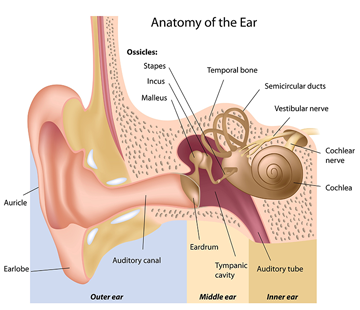
Typical causes for hearing loss
- Noise exposure
- Prebycusis (aging)
- Infections (Otisi Media, Otistis Externa)
- Head or ear trauma
- Congenitial abnormalities or genetics
- Ototoxic drugs (antibiotics, chemotherapy)
- Cerumen (wax) blockage
Types of Hearing Loss
Conductive
This involves outer and/or middle ear. It can be a result from infection, wax, or physical trauma. Can often be treated medically.
Sensorineural
Can be result of aging, ototoxic drug, head trauma, disease, genetic, etc. Also known as nerve deafness. It involves the inner ear or auditory nerve. Usually treatable and permanent. Treatment is amplification through use of hearing instruments.
Mixed Loss
A combination of conductive hearing loss and sensorineural hearing loss. Treatment is usually amplification through the use of hearing instruments.
Are two devices really better than one?
Yes. There are numerous advantages for wearing two devices over a single device. A majority of hearing professionals endorse the use of binaural (2 devices) when treating a hearing loss. The most notable difference will be a sense of balanced hearing.
- Reduces need for excessive volume
- Better sound direction
- Balanced hearing
- Improved hearing in noise
- More natural sound
Styles of hearing aids
In-the-ear:
With in-the-ear hearing aids, also called an ITE, the circuitry is built and housed into a custom ear mold that fills a majority of the visible portion of the ear. In-the-ear hearing aids are ideal for people with limited dexterity because of their size and easy-to-use controls
In-the-canal:
In-the-canal hearing aids, also referred to as ITC, are smaller than in-the-ear (ITE) hearing aids. ITC hearing aids are partially visible in the outer ear, but are far more discreet than an in-the-ear hearing aid. This type of hearing aid is best for mild to moderate losses.
Completely-in-the-canal:
Completely-in-the-canal or CIC hearing aids are custom-fit devices that fit all the way in the ear canal. They are barely visible therefore cosmetically appealing. These tiny hearing aids are best suited for individuals with a mild to moderate hearing loss. Some hearing aid wearers with narrow ear canals may not be able to wear CIC style hearing aids.
Over-the-ear (OTE):
Over-the-ear (OTE) hearing aids are smaller and less noticeable than traditional BTEs. Over-the-ear hearing aid is similar to traditional behind-the-ear hearing aids in that the shell fits behind the ear. Typically, a thin acoustic micro poly tube or transmission wire (in receiver-in-canal hearing aids) connects the shell to a custom ear mold or dome shaped ear bud.
